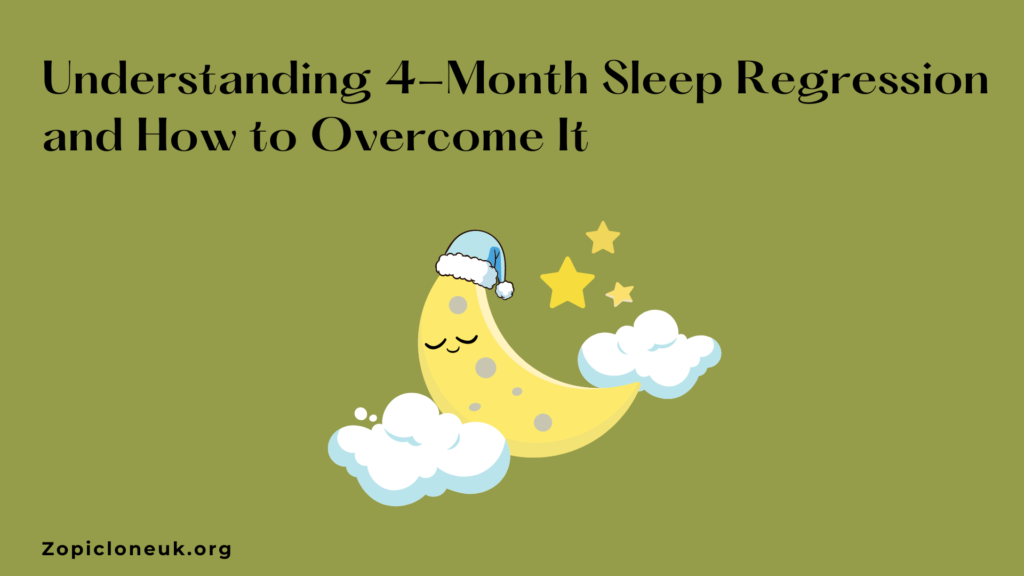
Sleep Regression 4-Month and How to Overcome It:- Sleep regression at four months is one of the most challenging phases for new parents. Just when your baby starts sleeping for longer stretches, they suddenly begin waking frequently at night, struggling to settle, and have shorter naps during the day. This phenomenon, known as the “4-month sleep regression,” is a natural developmental stage but can leave parents feeling exhausted and confused.
In this blog, we will explore the causes of the 4-month sleep regression, why it happens, and what you can do to support your baby—and yourself—through this period.
Contents
- 0.1 What Is Sleep Regression?
- 0.2 Why Does 4-Month Sleep Regression Happen?
- 0.3 Signs of 4-Month Sleep Regression
- 0.4 How Long Does the 4-Month Sleep Regression Last?
- 0.5 Tips for Managing 4-Month Sleep Regression
- 0.6 Extra Tips for Parents During 4-Month Sleep Regression
- 0.7 Extra Tips for Helping Your Baby Sleep
- 0.8 Frequently Asked Questions (FAQs)
- 0.9 Conclusion
- 1 Author Details
What Is Sleep Regression?
Sleep regression refers to a period where a baby who previously slept well suddenly starts waking up more frequently, napping less, or having trouble falling asleep. This phase is temporary and typically coincides with developmental milestones. The 4-month sleep regression is particularly notable because it is one of the first significant changes in a baby’s sleep patterns.
At around four months, babies experience rapid cognitive and physical development. This growth disrupts their sleep, leading to frequent night wakings and shortened naps during the day. Although frustrating, it’s important to remember that this phase is normal and won’t last forever.
Read Also:- What Is Sleep Regression?
Why Does 4-Month Sleep Regression Happen?
Several factors contribute to the 4-month sleep regression:
- Developmental Changes: At four months, your baby’s brain is developing rapidly, learning new skills like rolling, grabbing, and becoming more aware of their surroundings. These changes often impact their ability to stay asleep.
- Mature Sleep Patterns: At this stage, babies begin transitioning from newborn sleep patterns, which involve more deep sleep, to sleep cycles that resemble those of adults. These shorter, more fragmented cycles can cause babies to wake up between cycles.
- Increased Awareness: Babies at four months become more aware of their environment. They may struggle to settle because they notice things like the light, sounds, or even their own position in the crib. This heightened awareness can interfere with their ability to self-soothe back to sleep.
Signs of 4-Month Sleep Regression
How do you know if your baby is going through the 4-month sleep regression? Look for these signs:
- Frequent Night Wakings: A baby who used to sleep well may suddenly start waking up multiple times during the night.
- Shorter Naps: Daytime naps become shorter, with your baby waking after 20 to 40 minutes.
- Difficulty Falling Asleep: Your baby may take longer to settle, even if they used to fall asleep easily.
- Increased Fussiness: Due to disrupted sleep, your baby may be more irritable or fussy during the day.
- Changes in Feeding Patterns: Some babies may want to feed more frequently during this time, while others may show reduced interest in eating.
How Long Does the 4-Month Sleep Regression Last?
The 4-month sleep regression typically lasts between two to six weeks, although this can vary. Some babies may only experience a few days of disrupted sleep, while others may struggle for a longer period. It’s important to remain patient and consistent in your approach to helping your baby navigate this phase.
Tips for Managing 4-Month Sleep Regression
Managing the 4-month sleep regression can feel overwhelming, but there are steps you can take to make the process smoother for both you and your baby:
- Establish a Consistent Routine: Babies thrive on routine, especially during times of change. Create a calming bedtime routine that includes activities like bathing, reading, or singing lullabies. A consistent pre-sleep routine helps signal to your baby that it’s time to sleep.
- Focus on Daytime Sleep: Good daytime naps can lead to better nighttime sleep. Aim to provide a quiet, dark, and cool environment for naps, and try to keep nap times consistent.
- Encourage Self-Soothing: While it’s tempting to rush in and soothe your baby at every cry, try giving them a few moments to settle on their own. Teaching your baby to self-soothe can lead to better sleep habits.
- Ensure Comfort: Check that your baby’s sleep environment is comfortable, safe, and conducive to sleep. Make sure they are dressed appropriately for the temperature and that their sleep area is dark and quiet.
- Watch for Sleep Cues: Pay attention to signs that your baby is tired, such as yawning, rubbing their eyes, or becoming fussy. Putting them to bed before they become overtired can make it easier for them to fall asleep.
- Feed During the Day: Make sure your baby gets enough calories during the day, which can reduce the need for night feedings and help them sleep for longer stretches at night.
Extra Tips for Parents During 4-Month Sleep Regression
- Take Shifts: If possible, alternate night shifts with a partner to ensure both of you get some rest.
- Practice Patience: This phase, while difficult, will pass. Practice patience, knowing that it’s a normal part of your baby’s development.
- Ask for Help: If you feel overwhelmed, don’t hesitate to reach out to family, friends, or a healthcare provider for support.
Extra Tips for Helping Your Baby Sleep
- White Noise: Using a white noise machine can help block out external sounds that might wake your baby.
- Swaddling: For some babies, swaddling can provide comfort and a sense of security, helping them sleep better.
- Sleep Sack: If your baby has outgrown swaddling, a sleep sack can be a great alternative, offering the same cozy feeling without restricting movement.
Frequently Asked Questions (FAQs)
Q1: How can I tell if my baby is going through a sleep regression?
A: If your baby who previously slept well is suddenly waking up frequently at night, taking shorter naps, and has trouble falling asleep, they may be experiencing a sleep regression.
Q2: How long does the 4-month sleep regression last?
A: The 4-month sleep regression typically lasts between two to six weeks, but this can vary depending on the baby.
Q3: Will sleep return to normal after the 4-month sleep regression?
A: Yes, while sleep patterns may not return to the exact same rhythm as before, your baby will eventually establish a more consistent sleep routine.
Q4: Should I feed my baby when they wake up at night during the regression?
A: While some babies may need night feedings during this phase, it’s important to assess whether your baby is hungry or simply waking between sleep cycles.
Q5: Can sleep training help during the 4-month sleep regression?
A: Sleep training is a personal choice and can be effective for some families, but deciding what approach works best for you and your baby is essential.
Conclusion
The 4-month sleep regression is a significant developmental milestone that can be difficult for both parents and babies. It marks the beginning of your baby’s shift towards more mature sleep patterns, but with patience, consistency, and the right strategies, you can help your baby navigate this period successfully.
For parents looking to improve sleep further, Zopiclone is a prescription medication often used to treat insomnia in adults. This medication helps induce sleep and maintain a full night’s rest by working on the brain’s neurotransmitters. However, Zopiclone should be used under the guidance of a doctor and is typically prescribed for short-term use. Be sure to consult your healthcare provider for personalized advice if you are considering Zopiclone.
Author Details




Medical content by qualified psychiatrists
Our editorial policy

Zopiclone precautions Read our potential abuse notice

Looking for a seller? Locate the best Zopiclone vendor






